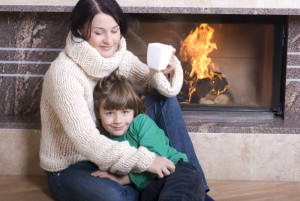A fireplace or stove is the perfect way to add both warmth and ambiance to your home. However, to maximize your enjoyment of your heating appliance it is important to know how to operate it safely. The following fire safety tips can help keep you and your family safe around your fireplace or stove, letting you enjoy it worry free.
1. Read the manual
Fireplace inserts and heating stoves all come with user’s manuals. Instead of shoving it into a forgotten drawer – or worse, throwing it out – take the time to read the manual. Fireplace manuals are an excellent resource that can provide you with important safety and operating information specific to your unit.
2. Keep children and pets away
Each year, thousands of children are injured by accidental fireplace burns. However, these accidents can be easily prevented by teaching fire safety as well as using preventative barriers. Fireplace screens or glass doors can be used to keep little hands – or paws – away from open flames. Likewise, physical barriers such as baby gates can be placed around fireplaces or stoves to prevent kids or pets from getting too close.
3. Test smoke alarms
It is important that all fireplace and stove owners install both smoke and carbon monoxide detectors in their homes. These lifesaving alarms can alert you in the event of a fireplace malfunction and are well worth the cost of installation and upkeep. Alarms should be installed on every floor of your home, including outside of sleeping areas. Test alarms every six months and replace batteries as needed; smoke and carbon monoxide detectors should be replaced at least once every 10 years in order to make sure they comply with current safety and technology standards.
4. Only burn firewood
While it may seem tempting to burn paper products or trash in your fireplace or stove, this can cause serious issues. Indoor heating appliances are only designed to burn firewood; burning any other materials can cause damage to the chimney system. In addition, fires where paper is burned can quickly get out of control or cause toxic chemicals from dyes to be released into the air. Instead, only burn seasoned firewood for a safe, controlled fire.
5. Have your chimney swept
Fireplace maintenance is a major part of fireplace operating safety. To keep your fireplace and chimney in their best possible condition, have your chimney swept at least once per year. An annual cleaning by a certified chimney sweep can remove soot and ash from the chimney structure as well as creosote, the highly flammable substance that is the leading cause of chimney fire.
By learning how to operate your fireplace or stove safely, you can rest assured that every member of your family will be able to enjoy your heating appliance. Contact Mason’s Chimney Service today for more information on fireplace and stove safety or to schedule your next chimney sweep appointment.

